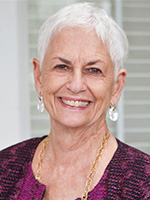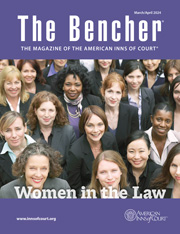Judge Stephanie Seymour: A True Trailblazer
The Bencher | March/April 2024
By Eric Turner, Esquire

 “Trailblazer” is the word often associated with Judge Stephanie Seymour, the U.S. Court of Appeals for the Tenth Circuit’s first female judge, who has witnessed significant changes in the legal landscape since joining the bench more than 40 years ago.
“Trailblazer” is the word often associated with Judge Stephanie Seymour, the U.S. Court of Appeals for the Tenth Circuit’s first female judge, who has witnessed significant changes in the legal landscape since joining the bench more than 40 years ago.
“I feel like an accidental role model,” Seymour said in a 2011 interview. “It’s nice to think that I may have influenced younger women to do something that they might not otherwise have done, like apply for a judgeship, take a chance on something, realizing they can have a career and have a family, anything in that regard. I mean, times have changed.”
Seymour’s judicial career almost didn’t get off the ground. The time was 1979. President Jimmy Carter took the rare step of establishing merit nominating commissions for federal appellate judges in an effort to open the process for a more diverse pool of candidates. At that time, there was only one sitting woman federal appellate judge in the country.
Seymour, then 39, applied. There were 35 applicants for a new Tenth Circuit judgeship, and to narrow down the list, the commission chair—a 70-year-old trial lawyer from Wyoming—suggested that each commission member name an applicant who’s obviously not qualified. He started and named Seymour. Josie Heath, a non-lawyer member of the commission from Denver, asked why. The chair said: “Because she has four children and couldn’t possibly handle the job.”
Heath was stunned. After some time to gather her thoughts, it eventually became her turn to eliminate an applicant. She named a sitting justice of the Oklahoma Supreme Court, which stunned the chair. “You can’t do that,” he said. “He’s obviously well-qualified.” Heath replied: “No, he’s got five children and couldn’t possibly handle the job.”
The point was made. Seymour’s name was placed back into consideration and was one of four the commission sent to President Carter. As they say, the rest is history. Carter nominated Seymour to be the first woman judge in the Tenth Circuit.
Seymour said she didn’t know how close she came to not being a judge until she heard the story from a mutual friend of Heath’s years later. In 2006, Heath—herself an inductee into the Colorado Women’s Hall of Fame—was introduced during the ceremonial presentation of Seymour’s portrait when she took senior status. Heath received a sustained ovation after Judge Robert Henry told the story.
Henry told many stories that day, telling those at The Broadmoor that Seymour was the first woman to be part of Harvard Law School’s moot court championship team, convincing the dean to list her first name—as opposed to the traditional first initial—on the permanent plaque so that other women would see.
In practice, she became the first woman hired as an attorney by Baker Botts before establishing herself as the first woman law partner in Tulsa. As a judge, she was the third woman to become chief judge of a circuit court when she served from 1994 to 2000, and she became the first woman to preside over the Judicial Conference of the United States in 1999.
Henry also told Seymour’s story through the words of others who contributed letters for the occasion.
President Jimmy Carter: “You’ve served the federal judiciary with distinction and have more than justified the faith I placed in you by appointing you to the U.S. Court of Appeals over two decades ago. The recognition you are receiving today is testimony to the impact you have made on the lives of those whom you have served so well.”
Justice Ruth Bader Ginsburg: “President Jimmy Carter cared deeply about the health and welfare of the federal judiciary. He aimed to, and succeeded in, changing the complexion of the third branch by appointing highly qualified women and members of minority groups to judicial office. The portrait you are about to see is no doubt beautiful, as Stephanie is. I expect it will also show that one need not be large to handle power successfully.”
Then-Chief Judge Deanell Tacha: “Stephanie Seymour has been a role model, mentor, respected colleague, and a dear friend to me. Whenever I think of Stephanie Seymour the judge, I think of those copious scrawled notes on the front of every brief. She has always been well-prepared, keenly engaged, probing in her questioning, and precise in her analysis. We have been so fortunate to have Stephanie Seymour as a chief and a colleague.”
Then-Tenth Circuit Clerk Betsy Shumaker: “Judge Seymour is part of the generation which made it happen for the rest of us. The amazing thing about her is that although she is a true trailblazer, none of us would ever have a vision of her slamming her fist through the proverbial glass ceiling. She is much too subtle for that. Rather, it is her quiet yet powerful competence that has always struck me. She has such an amazing intellect. We are awestruck by it. Yet, she gets real life. Her support meant the world to me. All because she gets it.”
Law clerk Mary Margaret Giannini: “When I think of Judge Seymour, Lady Justice comes to mind: A woman of strength, intelligence, insight, compassion, who renders balance and justice in the world. I learned a great deal about all of these things while working for Judge Seymour. However, what I treasure the most about Judge Seymour is what she taught me about balance. As demanding as her job is, and as hard as she works, Judge Seymour does not let the rigors of appellate judging render her life unbalanced. I am convinced that by living a balanced life, Judge Seymour was more able to render balanced justice. It is this lesson for which I am most grateful.”
Daughter Bria Simpson: “Growing up with my mom, I learned that there are no limits to what a woman can achieve. I see other women struggling with how to be a mom and be an individual, and I realize how lucky I am that it never occurred to me that one role might erase the other. She’s always been a mom and a strong woman. Of all that I’ve learned from my mom, this is what I value the most.”
Daughter Sara Crecca: “Most of my classmates had no idea my mother was a judge. She was never remotely interested in power or even just the image of power for power’s sake. She was always this sort of reformed shy person who would rather lay low and just be committed to doing her job well.”
In October 2020, Seymour was featured on a CBS Evening News segment as one of three trailblazers from the judicial class of 1979. That year, President Carter appointed 23 women to lifetime federal judgeships, more than doubling the number of women appointed as federal judges in the previous 190 years. Seymour was one of 11 appointed to a circuit court.
“We got used to, early on, dealing in a man’s world,” Seymour said. She recalled when she was pregnant and practicing law she went with one of the partners in her firm to a state court proceeding in a small town in Oklahoma. As she was following the male partner to the front of the courtroom, she said “the bailiff just threw his arms across the way after my male colleague went through, and he said only lawyers are allowed up here.” She said, “I stood up straight, stuck my belly out, and said I’m one of those and just pushed my way through.”
President Carter appointed Justice Ginsburg to the D.C. Circuit a year later in 1980. Seymour and her husband, Tulsa attorney Tom Seymour, became friendly with Ginsburg and her husband, Marty, through the years and had much in common.
“Stephanie is as blessed, as I am, in a marriage without artificial boundaries,” Ginsburg wrote in 2006. “Marty and I were drawn to Stephanie and Tom for that very reason—because they genuinely share the joys and sometimes trials of raising a family and because Tom and Marty regard their wives’ work as at least as important as their own.”
Seymour grew up in Battle Creek, Michigan, with three siblings in a family that often traveled the country for three months in the winter while being home-schooled in the car. She attended Smith College, an all-female school in Massachusetts. There, she took a political science course on the Constitution and set her sights on law school.
After graduating magna cum laude, she became one of 23 women in her class of 580 at Harvard Law. She had men ask her, “What are you doing here taking the place of a guy?” She responded: “There’s only 23 of me, what are you doing here taking the place of a woman?”
Times have changed, indeed. “When I graduated from law school in 1965, only 3% of the law school graduates in the country were women,” Seymour said. “By the mid-’70s, it had gotten close to 50%. So, I was just the beginning of a huge tide of women starting to go to law school. When I first became a judge, there were hardly any women in the courtroom, and that’s changed drastically. Being the first woman in a lot of things is fun. Times have just changed, and it’s been fun to watch that.”
Sources: Presentation of Portrait, Judicial Conference, September 9, 2006; Oral History Interview with Stephanie Kulp Seymour, Inductees of the Oklahoma Women’s Hall of Fame Oral History Project, interview by Juliana Nykolaiszyn, May 24, 2011; “Voices of Oklahoma,” Judge Stephanie Seymour, interview by John Erling, September 5, 2019; CBS Evening News, “These Three Trailblazers Paved the Way for Women in Judiciary,” interview by Jan Crawford, October 19, 2020.
Eric Turner, Esquire, is a special counsel with the Foulston law firm in Overland Park, Kansas, in the firm’s litigation and employment practice group. He is a member of the Earl E. O’Connor American Inn of Court.
This article, reprinted with permission, was originally published in the newsletter of The Historical Society of the Tenth Judicial Circuit, Vol. XI, Issue 1, Summer 2021.